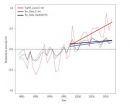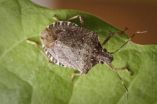(Press-News.org) South Africa has been financing domestic rainwater harvesting tanks in informal low-income settlements and rural areas in five of that nation's nine provinces. But pathogens inhabit such harvested rainwater, potentially posing a public health hazard, especially for children and immunocompromised individuals, according to a team from the University of Stellenbosch. The research was published ahead of print in Applied and Environmental Microbiology.
International studies had indicated that harvested rainwater frequently harbors pathogens, and that, in light of the financing of harvesting tanks, drove the investigators to study the matter locally, says principal investigator Wesaal Khan.
The sampling was conducted in the Kleinmond Housing Scheme, which was initiated by the South African Council for Scientific and Industrial Research and the Department of Science and Technology. The houses, designed to be sustainable, are approximately 400 square feet, with alternative technologies such as solar panels and the rainwater tanks.
The list of predatory prokaryotes the investigators found includes Legionella (found in 73% of samples), Klebsiella (47%) Pseudomonas (19% of samples), Yersinia (28%), Shigella (27%), and others. They also found some protozoan parasites, including Giardia (25% of samples).
Many of the pathogens are normal fresh water inhabitants, but Salmonella (6% of samples) indicates human fecal contamination, while Yersinia are markers of fecal contamination by wild and domestic animals, according to the report.
Residents, many of whom are little-educated and unemployed, typically use the rainwater for washing clothes and house-cleaning, but about one quarter of people polled in the study said they used it for drinking, as well. The finding that coliforms and Escherichia coli counts from rainwater samples—markers of fecal contamination—always significantly exceeded drinking water guidelines, reinforces the World Health Organization's opinion that rainwater must be pretreated prior to use for drinking, says Khan.
Rainwater harvesting is needed in South Africa's "informal communities" because residents often depend on communal "standpipe" systems that frequently serve more than 100 people, who may have to walk as far as a third of a mile to get water, says Khan. Approximately 23,000 rainwater tanks have been installed, two thirds of them in the Eastern Cape and one third in KwaZulu Natal. Nearly 20% of South Africans lack sustainable access to water.
INFORMATION:
A copy of the manuscript can be found online at http://bit.ly/asmtip0214f. The final version of the article is scheduled for the April 2014 issue of Applied and Environmental Microbiology.
Applied and Environmental Microbiology is a publication of the American Society for Microbiology (ASM). The ASM is the largest single life science society, composed of over 39,000 scientists and health professionals. Its mission is to advance the microbiological sciences as a vehicle for understanding life processes and to apply and communicate this knowledge for the improvement of health and environmental and economic well-being worldwide.
Harvested rainwater harbors pathogens
2014-02-26
ELSE PRESS RELEASES FROM THIS DATE:
No warming hiatus for extreme hot temperatures
2014-02-26
Extremely hot temperatures over land have dramatically and unequivocally increased in number and area despite claims that the rise in global average temperatures has slowed over the past 10 to 20 years.
Scientists from the ARC Centre of Excellence for Climate System Science and international colleagues made the finding when they focused their research on the rise of temperatures at the extreme end of the spectrum where impacts are felt the most.
"It quickly became clear, the so-called "hiatus" in global average temperatures did not stop the rise in the number, intensity ...
Beta-catenin alters T cells in lasting and harmful ways
2014-02-26
Activation of beta-catenin, the primary mediator of the ubiquitous Wnt signaling pathway, alters the immune system in lasting and harmful ways, a team of Chicago-based researchers demonstrate in the February 26, 2014, issue of Science Translational Medicine.
An increase in beta-catenin in certain types of T cells—a class of white blood cells—causes chronic inflammation in the intestine and colon, eventually leading to cancer. The same mechanism is used by colon cancer to propagate itself. The researchers combine data from patients suffering from colitis or colon cancer ...
Hubble monitors supernova in nearby galaxy M82
2014-02-26
This is a Hubble Space Telescope composite image of a supernova explosion designated SN 2014J in the galaxy M82. At a distance of approximately 11.5 million light-years from Earth it is the closest supernova of its type discovered in the past few decades. The explosion is categorized as a Type Ia supernova, which is theorized to be triggered in binary systems consisting of a white dwarf and another star — which could be a second white dwarf, a star like our sun, or a giant star.
Astronomers using a ground-based telescope discovered the explosion on January 21, 2014. This ...
Characterization of stink bug saliva proteins opens door to controlling pests
2014-02-26
Brown marmorated stink bugs cause millions of dollars in crop losses across the United States because of the damage their saliva does to plant tissues. Researchers at Penn State have developed methods to extract the insect saliva and identify the major protein components, which could lead to new pest control approaches.
"Until now, essentially nothing was known about the composition of stink bug saliva, which is surprising given the importance of these insects as pests and the fact that their saliva is the primary cause of feeding injury to plants and crop losses," said ...
New data book outlines Hispanic/Latino health
2014-02-26
The National Heart, Lung, and Blood Institute, part of the National Institutes of Health, released the largest and most comprehensive health and lifestyle analysis of people from a range of Hispanic/Latino origins. The data will enable individuals, communities, and policy makers to tailor better health intervention strategies.
"This study lays the foundation for future research on the possible causes of chronic diseases and ways to prevent them, and to help us understand the reasons why Hispanics and Latinos live longer than the general population," said Gregory Talavera, ...
Research maze puts images on floor, where rodents look
2014-02-26
PROVIDENCE, R.I. [Brown University] — A rodent in a maze is a staple — even a stereotype — of experimental psychology research. But the maze in the lab of Rebecca Burwell, professor of cognitive, linguistic, and psychological sciences at Brown University, is not your grandfather's apparatus. In a new video article published in the Journal of Visualized Experiments, Burwell's research group demonstrates in full detail how the maze can be used to perform automated visual cognitive research tasks with great efficiency.
The article is available here: http://www.jove.com/video/51316/automated-visual-cognitive-tasks-for-recording-neural-activity-using
The ...
Mayo Clinic discovers African-Americans respond better to rubella vaccine
2014-02-26
ROCHESTER, Minn. — Feb. 26, 2014 — Somali Americans develop twice the antibody response to rubella from the current vaccine compared to Caucasians in a new Mayo Clinic study on individualized aspects of immune response. A non-Somali, African-American cohort ranked next in immune response, still significantly higher than Caucasians, and Hispanic Americans in the study were least responsive to the vaccine. The findings appear in the journal Vaccine.
"This is fascinating," says Gregory Poland, M.D., Mayo Clinic vaccinologist and senior author of the study. "We don't know ...
JILA physicists discover 'quantum droplet' in semiconductor
2014-02-26
BOULDER, Colo -- JILA physicists used an ultrafast laser and help from German theorists to discover a new semiconductor quasiparticle—a handful of smaller particles that briefly condense into a liquid-like droplet.
Quasiparticles are composites of smaller particles that can be created inside solid materials and act together in a predictable way. A simple example is the exciton, a pairing, due to electrostatic forces, of an electron and a so-called "hole," a place in the material's energy structure where an electron could be, but isn't.
The new quasiparticle, described ...
Pine forest particles appear out of thin air, influence climate
2014-02-26
Pine forests are especially magical places for atmospheric chemists. Coniferous trees give off pine-scented vapors that form particles, very quickly and seemingly out of nowhere.
New research by German, Finnish and U.S. scientists elucidates the process by which gas wafting from coniferous trees creates particles that can reflect sunlight or promote cloud formation, both important climate feedbacks. The study is published Feb. 27 in Nature.
"In many forested regions, you can go and observe particles apparently form from thin air. They're not emitted from anything, ...
A predictive fitness model for influenza
2014-02-26
Researchers at Columbia University and the University of Cologne have created a new model to successfully predict the evolution of the influenza virus from one year to the next. This advance in our understanding of influenza suggests a new, systematic way to select influenza vaccine strains. The findings appear in Nature on Feb. 26.
The flu is one of the major infectious diseases in humans. Seasonal strains of the influenza A virus account for about half a million deaths per year. In a concerted effort, WHO and its Collaborating Centers have closely monitored the evolution ...




